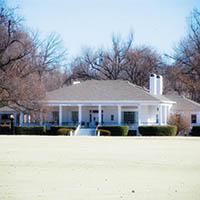Bottomline: Closing in
Closing in on someday
 In his 68-page ruling, U.S. District Court Judge Terrence Kern, like the Utah judge before him, invoked United States v. Windsor, making him the third federal judge to strike down a state ban on gay marriage, behind Utah and California.
In his 68-page ruling, U.S. District Court Judge Terrence Kern, like the Utah judge before him, invoked United States v. Windsor, making him the third federal judge to strike down a state ban on gay marriage, behind Utah and California.
“Equal protection is at the very heart of our legal system and central to our consent to be governed,” wrote in the ruling. “It is not a scarce commodity to be meted out begrudgingly or in short portions. Therefore, the majority view in Oklahoma must give way to individual constitutional rights.”
Two of the plaintiffs, Tulsans Mary Bishop and Sharon Baldwin, weren’t expecting a ruling, or the whirlwind of media attention that followed in its wake. “We’re jubilant, we’re over the moon,” Baldwin told The New York Times.
Bishop cried when the ruling came down. “It’s overwhelming to think that we finally won,” she told The Associated Press on Jan. 14. “This is something that when I was young, I thought I’d never see in my lifetime.”
In the swoop of a single June day, the Supreme Court kicked the door open for same-sex rights in America – but no one was sure just how far open. “The Supreme Court’s landmark gay-rights decision in United States v. Windsor, last June, has become even more evident in the past month, thanks to a series of important lower-court decisions that have interpreted it broadly,” pronounced The New Yorker in a Jan. 27 analysis.
Four states moved to legalize same-sex marriage in the months after the Windsor decision: first, New Jersey then Hawaii, Illinois, and New Mexico. Currently, 17 states and the District of Columbia allow same-sex marriage. This time last year, that number was nine.
Just before Christmas, Utah’s federal court invoked Windsor when it ruled the Constitution allowed for the right to same-sex marriage, turning up the heat on the long-languishing case in Oklahoma.
Kern’s ruling made headlines in major news outlets across the nation. The New York Times’ Jan. 14 story led with this: “A federal judge in Oklahoma ruled Tuesday that the state’s constitutional amendment barring same-sex marriage violated the federal Constitution, the latest in a string of legal victories for gay rights and one that occurred in the heart of the Bible Belt.”
After a spate of stories announcing Kern’s decision, outraged statements poured in from dissenting conservative politicians. Said Oklahoma State Rep. Sally Kern, R-Oklahoma City: “Homosexuality is not a civil right, it’s a human wrong.”
The cover of Tulsa Beacon, a conservative Christian newspaper, ran the headline, “Judge rules in favor of Tulsa World lesbians: Christians react to overturning marriage act,” in its Jan. 23 edition. The article quoted Oklahoma State Rep. Mike Turner, R-Edmond, who filed a bill calling for a second vote to ban gay marriage in the state, via constitutional amendment. He called his bill “an arrow in the quiver” for House leadership who aim to overturn Kern’s ruling and reinstate the ban.
Turner also filed a shell bill, The Preservation of Marriage Act, which could prevent all marriage in Oklahoma.
“My constituents are willing to have that discussion about whether marriage needs to be regulated by the state at all,” Turner told News 9, Oklahoma City, on Jan. 24.
Three days after Kern’s ruling, Tulsa County Court Clerk Sally Howe Smith, the primary defendant in the case, filed an appeal. Smith’s defense team is Alliance Defending Freedom, a conservative Christian nonprofit based in Arizona. ADF was founded in 1994 by a ring of prominent Religious-Right preachers, including James Dobson, Larry Burkett, and Bill Bright. The group is headed by Alan Sears, who is co-author of ,“The Homosexual Agenda: Exposing the Principal Threat to Religious Freedom Today,” among others.
The “family values” nonprofit targets high-profile, controversial cases. It represented proponents of Prop 8 and had a hand in Boy Scouts of America v. Dale, the landmark case that ruled in favor of BSA after the organization fired a gay Scoutmaster.
Bottom Line: In November 2004, the resolution to institute a gay marriage ban in Oklahoma passed in a landslide: 75 percent of the vote. But the times, they are a’changin’. There’s been a shift in our politics and culture in the nine years since the ban took effect. According to a July 2013 Gallup poll, 54 percent of Americans supported same-sex marriage. There is an unscientific reader poll on the Tulsa World website, which asks, “Does Oklahoma’s same-sex marriage ban violate the U.S. Constitution?” As of Jan. 31, 90.5 percent of readers responded that it does.
History, demolished
 River Parks-goers were surprised as they watched demolition crews tear down one of Tulsa’s most notable homes on Saturday, Feb. 1. The B.B. Blair Mansion, a white plantation-style mansion on 33 sprawling acres along Riverside Drive, could not be saved, its former owner said.
River Parks-goers were surprised as they watched demolition crews tear down one of Tulsa’s most notable homes on Saturday, Feb. 1. The B.B. Blair Mansion, a white plantation-style mansion on 33 sprawling acres along Riverside Drive, could not be saved, its former owner said.
In 1952, B.B. and Priscilla Blair began designing their dream home. They broke ground in 1958 with the help of architect John Duncan Forsyth. The inspiration for the expansive homestead with white columns and elevated front porch was Jefferson Davis’s Biloxi, Miss., plantation, Beauvoir. Davis’s name is vaguely familiar for a reason—he was the one and only president of the Confederate States of America.
The George Kaiser Family Foundation purchased the mansion and surrounding acreage for the multimillion-dollar project dubbed A Gathering Place for Tulsa. The sale agreement with former homeowner, Dan Buford, allowed him to dismantle the house and move it to a new location, but the logistics of such a move proved too difficult. Buford wrote an open letter addressed to his fellow Tulsans, dated Jan. 31: “This has been a very difficult decision for me,” he wrote.
Burford hired a local company to try to figure out where to move the home how to make the move without damaging the structure, overpasses, or streets, he wrote. “They wouldn’t say that it couldn’t be moved, but they didn’t see how it was worthy or feasible,” he told Tulsa World.
The mansion was never part of GKFF’s plan for A Gathering Place for Tulsa, a 60-plus-acre park and recreation area planned for the area along Riverside Drive between 24th and 31st Streets. Construction on the project will break ground sometime this year, with a completion date slated for 2016-2017.
Bottom Line: Despite a dubious connection to the past, the Blair Mansion was a cherished piece of Tulsa’s riverfront for six decades. We bid a fond farewell to the old and welcome a new chapter in Tulsa’s history.


.jpg)
.jpg)
